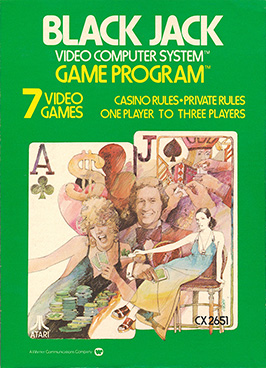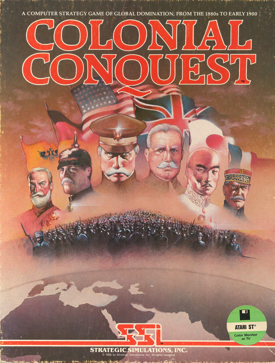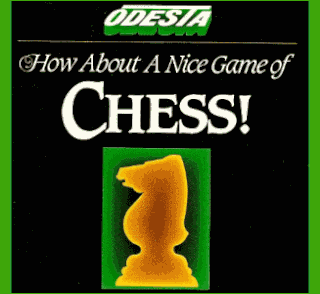| Chess 7.0 | |
|---|---|
 | |
| Publisher(s) | Odesta |
| Platform(s) | Apple II, Atari 8-bit, Commodore 64, MS-DOS |
| Release | 1982 |
Chess 7.0 is a 1982 video game published by Odesta.
| Chess 7.0 | |
|---|---|
 | |
| Publisher(s) | Odesta |
| Platform(s) | Apple II, Atari 8-bit, Commodore 64, MS-DOS |
| Release | 1982 |
Chess 7.0 is a 1982 video game published by Odesta.
Chess 7.0 is a chess game with 17 different levels of skill, and includes 27 special features. [1]
David Long reviewed the game for Computer Gaming World , and stated that "Odesta's Chess 7.0 probably has the most powerful chess solitaire play capability now available for home computers. You will find it extremely entertaining even if chess is not your favorite game. I hope that more designers will try to reach this level of solitaire capability in other types of computer games." [1]

Pong is a table tennis–themed twitch arcade sports video game, featuring simple two-dimensional graphics, manufactured by Atari and originally released on 29 November 1972. It was one of the earliest arcade video games; it was created by Allan Alcorn as a training exercise assigned to him by Atari co-founder Nolan Bushnell, but Bushnell and Atari co-founder Ted Dabney were surprised by the quality of Alcorn's work and decided to manufacture the game. Bushnell based the game's concept on an electronic ping-pong game included in the Magnavox Odyssey, the first home video game console. In response, Magnavox later sued Atari for patent infringement.

Bloodwych is a dungeon role-playing video game, a dungeon crawler, developed for the Amiga, Atari ST, MS-DOS, Amstrad CPC, Commodore 64, and ZX Spectrum. Its box featured artwork by Chris Achilleos. The plotline identifies the player as a champion of Trazere who, after recruiting up to three fellow champions, travels through dungeons and mazes fighting creatures along the way to find and destroy the evil Zendick, and banish the Lord of Entropy.

Archon: The Light and the Dark is a 1983 video game developed by Free Fall Associates and one of the first five games published by Electronic Arts. It is superficially similar to chess, in that it takes place on a board with alternating black and white squares, but instead of fixed rules when landing on another player's piece, an arcade-style fight takes place to determine the victor, and each piece has different combat abilities. The health of the player's piece is enhanced when landing on a square of one's own color.
The fog of war is the uncertainty in situational awareness experienced by participants in military operations. The term seeks to capture the uncertainty regarding one's own capability, adversary capability, and adversary intent during an engagement, operation, or campaign. Military forces try to reduce the fog of war through military intelligence and friendly force tracking systems.
Chessmaster is a chess-playing video game series, which is owned and developed by Ubisoft. It is the best-selling chess franchise, with more than five million units sold as of 2002. The same cover art image featuring Will Hare was used from Chessmaster 2000 to Chessmaster 9000.

Blackjack is a video game simulation of the card game blackjack. It was designed by Bob Whitehead for the Atari Video Computer System. The game allows up to three players to play a variation of blackjack. Each player is given 200 chips where they can bet 1 to 25 of each round. The game ends for a player when they either run out of chips or earns 1000 chips or more.

Basketball is a sports video game programmed by Alan Miller for the Atari Video Computer System and published by Atari, Inc. in 1978. The cartridge presents a game of one-on-one basketball for by one or two players, one of the few early VCS titles to have a single-player mode with an AI-controlled opponent. Miller wrote a version of Basketball for Atari 8-bit computers with improved graphics, published in 1979. That same year, an arcade version similar to the computer port was released by Atari but in black and white.

Microchess, sometimes written as MicroChess, is a chess program developed for the MOS Technology KIM-1 microcomputer by Peter R. Jennings in 1976, and published by his company Micro-Ware. The game plays chess against the human player at a beginner level, with the player entering moves via a keyboard and the computer responding, both in a custom chess notation. The game was ported to many other microcomputers such as the TRS-80, Apple II, Commodore PET and Atari 8-bit family computers by Micro-Ware and its successor company Personal Software between 1976 and 1980, with later versions featuring graphics and more levels of play. A dedicated hardware version of the game called ChessMate was produced by Commodore International in 1978, and the game's engine was licensed to Novag for its dedicated Chess Champion Mk II chess computer in 1979.

Datamost was a computer book publisher and computer game company founded by David Gordon and based in Chatsworth, California. Datamost operated in the early 1980s producing games and other software mainly for the Apple II, Commodore 64 and Atari 8-bit family, with some for the IBM PC. It also published educational and reference materials related to computers and computer programming.
Chess was a pioneering chess program from the 1970s, written by Larry Atkin, David Slate and Keith Gorlen at Northwestern University. Chess ran on Control Data Corporation's line of supercomputers. Work on the program began in 1968 while the authors were graduate students at the university. The first competitive version was Chess 2.0 which gradually evolved to Chess 3.6 and was rewritten as the 4.x series. It dominated the first computer chess tournaments, such as the World Computer Chess Championship and ACM's North American Computer Chess Championship. NWU Chess adopted several innovative or neglected techniques including bitboard data structures, iterative deepening, transposition tables, and an early form of forward pruning later called futility pruning. The 4.x versions were the first programs to abandon selective search in favor of full-width fixed-depth searching.

The Fidelity Ultimate Chess Challenge is a chess video game released in 1991 by Telegames for the Atari Lynx. Players can either play against the game or against another player using the same console. The game engine was written by Fidelity Electronics, makers of various chess computers, and reached a master rating of 2325 Elo.

Legionnaire is a computer wargame for Atari 8-bit computers created by Chris Crawford released through Avalon Hill in 1982. Recreating Julius Caesar's campaigns in a semi-historical setting, the player takes command of the Roman legions in real-time battles against the barbarians.

The Chessmaster 2000 is a computer chess game by The Software Toolworks. It was the first in the Chessmaster series and published in 1986. It was released for Amiga, Apple II, Atari 8-bit family, Atari ST, ZX Spectrum, Commodore 64, Amstrad CPC, MSX, Macintosh, and IBM PC compatibles.

Preppie! is an action video game for Atari 8-bit computers published by Adventure International in 1982. It was programmed by Russ Wetmore of Star Systems Software, whose name is prominently displayed on the box cover. Leaning on the preppy trend of the early 1980s, the game follows prep schooler Wadsworth Overcash as he navigates the hazards of a country club to retrieve golf balls. Preppie! borrows heavily from Konami's Frogger, with lanes of traffic in the bottom half of the screen and a river crossing the top portion. Alligators are an element from both Frogger and preppy fashion; an open-mouthed gator is the icon of shirt brand Izod. Reviewers recognized the game as derivative, but called the music and visuals some of the best for Atari 8-bit computers.

Getaway! is a crime-themed, multidirectional-scrolling maze game for Atari 8-bit computers. It was designed by Mark Reid and published by the Atari Program Exchange (APX) in 1982. In Getaway!, the player drives around a large city stealing cash, valuable items, and the contents of armored trucks, then must return the loot to their hideout. Three different police vehicles pursue, getting more aggressive as more crimes are committed.

Colonial Conquest is a turn-based strategy video game developed by Strategic Simulations and released in 1985 for the Atari 8-bit family and Commodore 64, followed by the Apple II in 1986. Ports by Andromeda Software were released for the Atari ST in 1987 and PC-98 in 1989.

Sargon II is a sequel to Sargon. Both are computer chess programs for home computers.

Computer Ambush is a 1980 video game published by Strategic Simulations.

How About A Nice Game of Chess? is a 1984 video game published by Odesta.

Imperium Galactum is a 1984 video game designed by Paul Murray and published by Strategic Simulations.